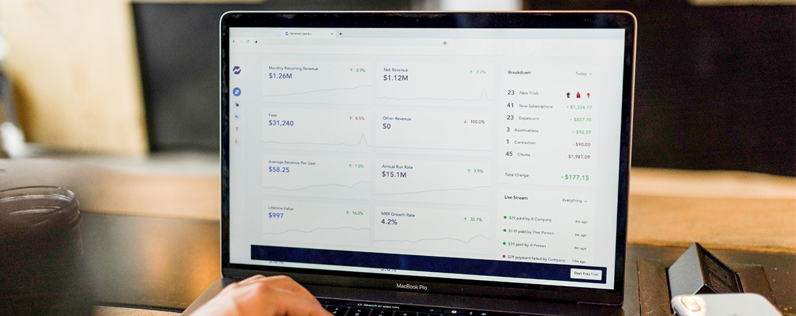
Whatever type of business you have online, you need data so you can chart trends, analyze performance, and understand your customer. Put simply, website analytics lets you see what is and isn’t working for your website. And today, in a digital age, it’s one of the most important tools you can use to grow your company, drive sales, and outclass your competition. Fortunately for you, Constant Contact’s platform has all the website tracking tools you need to reach these goals.
If you’re new to this and you feel overwhelmed, there’s no need. Below, we’ll cover everything you should know, including:
- What is web analytics
- How to check website traffic
- Key performance indicators
Ready to get your website to where you want it to be? Let’s go.
What is web analytics?
At its essence, web analytics is all about compiling website data into an ordered, readable, and logical way. It tells you what’s happening on your website on a daily, weekly, monthly or even yearly basis. And the information you can gather is seemingly limitless. For example, you can get data to answer questions like:
- Who it was that came to your website?
- How long did they stay?
- Where did they come from?
- What content did they like or respond to?
Or you can find website information on a larger scale, finding information on the following:
- Overall site visits
- Which pages users spent the most time on
- Where users came from
- Click-through rate (CTR)
- Conversion rate
With the right website analytics tools, this information can be incredibly useful, allowing you to monitor trends and maximize traffic. This lets you gauge the effectiveness of your website, see how you’re drawing them in, and measure what does or doesn’t keep them engaged.
Key performance indicators (KPIs) your analytics should be tracking
Once you find the right information, you need to know what to do with it. There are several KPIs that you should track. They include:
Traffic
Overall traffic is the total number of site visits your website receives over a period of time. While increased site visitors is always a good sign, it’s not enough to just have an upward trend. In fact, if your website is receiving more traffic but fewer sales, that could be a sign that the early part of your sales funnel is succeeding but the later parts are failing. Your traffic numbers need the context of other KPIs in order to determine whether what is really happening.
Domain authority and search rankings
Domain authority includes how authoritative your website is perceived by Google and search rankings pertain to what position you show up on the search engine results page. If your goal is to measure how successful your search engine optimization (SEO) efforts have been sitewide and on your blog, these metrics let you see how your content or promotional efforts reacted to the search engine’s algorithms. But, similarly to traffic, a high domain authority doesn’t matter if you’re not also receiving increased site visits.
Bounce rate
If a person visits your site and then leaves, that counts as a “bounce.” The bounce rate is determined by dividing bounces by overall traffic numbers. The lower the number, the better your website performance. Bounces aren’t good, but they are inevitable. In fact, most sites have a bounce rate between 20% and 70%. Naturally, your goal is to minimize bounces. To do so, you want to avoid the common pitfalls that cause people to leave, including:
- Slow load times
- An ugly web design aesthetic
- Hard-to-follow navigation
- Annoying ads
- Visitors seeing something different than what they were expecting
- Non-skimmable content
- Content filled with spelling and grammatical errors
- Hard-to-read or visually unappealing landing pages
Average time on page
This figure lets you see how long a person spent on a web page, or which pages were “stickier” than others. Ideally, the longer they stay on a page the better — to a certain point. Average time on page is especially important to use in conjunction with bounce rate. This lets you see whether they’re clicking your link and then immediately leaving, or if they’re scrolling, scanning, or reading the entire page. Generally speaking, high bounce rates will also have a low average time on page.
Unique site visitors
One of the main goals of your marketing efforts is to constantly reach new customers. For this reason, your unique site visitors is one of the most important KPIs you’ll want to keep track of. It gives you insights into who ( which demographics) is responding to your material. This lets you build out profiles for your target users — the type of person you should be targeting going forward.
Conversion rates (CR)
Conversion rates give you insight into the success of your campaigns and marketing efforts. It represents the number of potential sales opportunities out of the total website traffic. Conversions are the people who are reacting positively to your call to action (CTA) and overall messaging.
With this information, you can identify how your visitors are purchasing compared to all website traffic and make CRO (conversion rate optimization) improvements to your website where necessary.
Traffic sources
The vast majority of first-time visitors will not be visiting your website by entering your URL. Instead, they’ll be coming from one of several links. Typically, they arrive from one of four primary categories:
- Search engines
- Other website links
- Social media links
- Email campaign links
Your mission should be to capitalize on all four potential traffic sources. That said, search engines are the most important since they have the highest potential to bring in the largest traffic flow. In addition, by ranking higher on search, you’re more likely to receive links from other websites since you’re viewed as a trustworthy source.
Desktop vs. mobile visits
In recent years, mobile surpassed desktop in terms of total traffic. More people are searching and buying on their phones than on their laptops. Because of this, it’s essential that your website is optimized for mobile. If you have high desktop visits but low mobile visits, odds are, something is wrong with the mobile site. Even if your site is tailored for desktop —for whatever reason — going forward, you need to make your website mobile-responsive.
Page load time
An important factor for bounce rates, this measures the time it takes for the content on your webpage to load — slow-loading pages lead to unhappy users and higher bounce rates. There are several factors that impact load times, including:
- Page design
- Hosting server
- Total number of elements on page
- Browser type
- User’s location
- Too many pixels
Dwell time
This is a metric that tends to go overlooked, but shouldn’t. It paints a vivid picture of how compelling your website and your content actually is. It’s important to note that this is not the same as the average time on page indicator. So what is it? Dwell time is the length of time a user spends viewing a webpage after they’ve clicked a link on a search results page (before they return to the search results page).
Longer dwell times mean that people are staying and absorbing the content on your website, which increases the likelihood that they’ll move further down the sales funnel.
New and returning visitors
Ideally, your visitors come once and then keep on returning daily, if not several times a day. Those types of users are classified as return visitors. They’re your primary audience and main focus. A solid recurring traffic rate to shoot for is around 20% to 30%. From there, your goal is to keep on building that number by enticing a steady stream of new users to the website.
Track your website traffic
The analytics portion of your website should not go overlooked. Without it, you have no way to see whether or not the changes you implement or the decisions you make are impacting the site positively or negatively.




